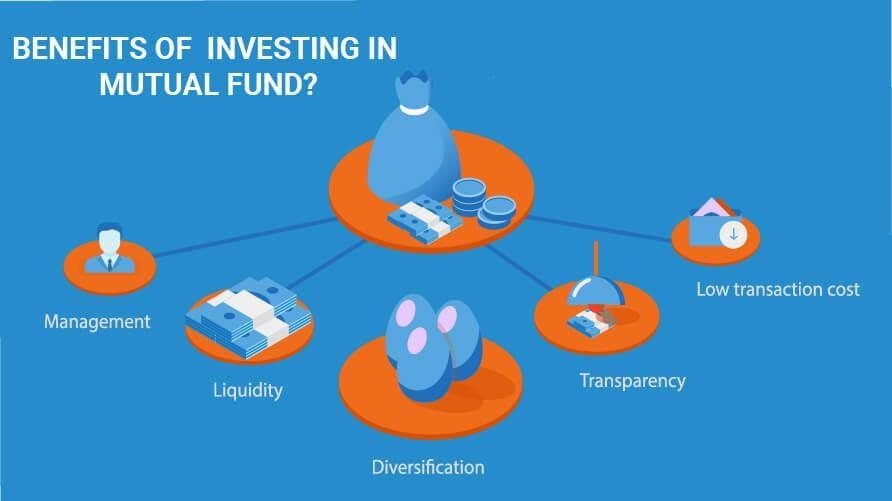
Currently, around 44.8% of households in the USA possess mutual funds. They allow you to invest in more than one underlying asset through a single investment, accessing a bunch of bonds and stocks in an instant. Traders investing in mutual funds buy the shares of an organization that itself is engaged in purchasing the stocks of other businesses.
What are mutual funds?
Mutual funds are investment trusts where people store their capital and gain profits over time. Every mutual fund has a person managing it, and every investor has units reflecting their share in the fund. They receive their profits or losses on the basis of how much they contributed.
Benefits of investing in mutual funds

The main benefits of mutual funds are as follows:
- Diversification. If you hold a small account, diversification of your portfolio can be challenging indeed. When you employ a diversification strategy, you can reduce the risks attached to a poorly performing trade. With mutual funds, you can pool your capital with other traders, which lets you purchase different investment options, thus allocating your money equally among all of them.
- Reinvesting dividends. Since you need to state your dividends and sources of earning for a mutual fund, you can buy more shares and grow your investment further.
- Reasonable pricing. It is not too difficult to comprehend and purchase mutual funds. The minimum amount you need to invest in a mutual fund is not that much, and the trading occurs only a single time every day. This essentially reduces the chances of a price swing to zero.
- Simplicity. Mutual funds are simple enough, and you don’t need to be a financial expert in order to make profits. You can invest in mutual funds without carrying out a thorough study of economic statements, purchasing a basket of securities, and spreading your capital among them.
- Managed by professionals. With this type of investment, you don’t need to spend several hours carrying out complicated financial analysis in order to find perfect investment opportunities. You don’t have to devote as much time to this since there are professionals who analyze your investments.
Investing in a mutual fund in 5 steps

Investing in mutual funds involves the following steps.
Step 1: Know your investment purpose and budget
First and foremost, you need to set your investment objective. It could be a number of things like saving up for retirement, planning a wedding, children’s education, purchasing a property, etc. In case you don’t have anything specific in mind, you should be clear regarding the amount of money you wish to earn and how soon you wish to earn it.
Additionally, you need to set a budget, i.e., how much you plan to invest at the beginning. While some brokers require you to invest a minimum amount, others don’t have such rules, so you can put in any amount of money you wish. If you wish to save for retirement, conservative investments will be better suited for you, whereas greater risks can be taken if you are young.
Step 2: Choose the right active or passive mutual fund
Next, you should decide whether you wish to choose a passive or an active fund. While the former monitors a benchmark index, the latter takes the help of experts who pick out the investments. Active mutual funds aim to outperform a specific index, while passive mutual funds simply attempt to match it.
That being said, active mutual funds seldom outperform the benchmark indexes. So, before you put your money into an active mutual fund, you should carefully look at historical data. This will give you an idea regarding how well it can perform in the market.
Step 3: Scrutinize the costs
Remember, you need to pay a certain portion of your investment amount as a sales charge, and you must calculate the cost of investment, even though it can get a bit complicated. You will be provided with an expense ratio, and you can compute the dollar amount from it by dividing the portion of the end-quarter share price represented by that percentage.
Additionally, you need to consider the sales load, which is the commission you need to pay to the broker or advisor when you invest in mutual funds. You have to pay this fee while you are purchasing the share and also while you are redeeming it.
Step 4: Mull over the risk factors
There are many macroeconomic factors that can affect a company’s performance, thus increasing the volatility risk. Then comes the concentration risk that increases when you centralize most of your investment in one sector. Additionally, there is the possibility that the interest rate increases after the investment, which forces you to sell the bond at a price lower than what you invested.
Most of the schemes that promise large profits often have high risks attached to them. If you are prepared to take high risks in the hope of making huge profits, equity schemes are what you should go for. Conversely, if you only wish to make small profits and do not have the stomach for risky investments, debt schemes will suit you quite well.
Step 5: Build and manage your portfolio
The amount of your portfolio you ought to commit for the purpose is vital. This choice should be based on your financial requirements, and your portfolio can consist only of mutual funds if carrying out automated trading is what you desire.
One of the things experienced traders do is rearranging their portfolios every year while perpetuating the diversification strategy. For example, suppose a part of your investments performed excellently and currently make up the lion’s share of the basket. In that case, you can sell off your profits and look for another investment area in order to diversify your capital.
Bottom line
Remember, you may need to take the help of a brokerage firm to deal with a vast number of available options. If your investment plan is fairly diverse, you can go for a discount brokerage where the fees are reasonable.








This are great tips to live by to get a good use of your money for mutual funds, kudos!